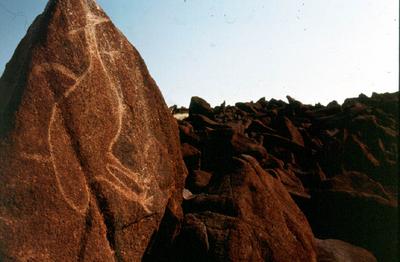Letter to Dampier ‘Emissions Committee’
 |
14 August 2003
Professor Frank Murray
School of Environmental Science
Murdoch University
Perth, WA 6150
Dear Professor Murray,
Re: Preservation of Murujuga (Burrup) rock art
State Development Minister Clive Brown has announced tenders for six studies under the aegis of the Burrup Rock Art Monitoring Management Committee which you chair:
1. Baseline assessment of microbial activity on rock surfaces;
2. Microclimate and deposition at rock art sites;
3. Monitoring of ambient concentrations of industrial emissions;
4. Artificial fumigation of rock surfaces;
5. Field studies of colour changes to rock art; and
6. Field studies of micro-topography changes to rock art.
In response I offer the following comments:
1. Microbial activity is hardly relevant, the main problem, as has been adequately established by previous study, is industrial acidification. It is possible, but improbable, that this has also exacerbated microbial action, but this is at most a peripheral issue.
2. Microclimate and deposition: deposition of fine particle fallout has certainly been a problem since the establishment of the Hamersley Iron plant, which has spewed out 518,000 tonnes of particulate matter of under 10 microns so far. Further quantification is of marginal interest, it is certainly not the most pressing issue here. Microclimatic study appears to be a soft option, and is hardly relevant to the main issue, that of acidification. Microclimate has been subjected to extensive studies in rock art conservation, with very little if any useful data having been acquired that way.
3. Ambient concentrations of industrial emissions: this is most useful because appropriate data remain unavailable. It is of course necessary to check levels against a control site, a safe distance away, and I trust that such data will be required.
4. Fumigation of rock surfaces: we already had fumigation with hundreds of thousands of tonnes of NOx and SOx, not to mention hundreds of millions of tonnes of CO2 and 80,000 tonnes of volatile hydrocarbons. What is the purpose of this proposal? Are you assuming that the rock art is being damaged by biota? How do you propose to fumigate the peninsula, and with what?
5. Colour changes to rock art: a highly valid requirement, bearing in mind that this is what determines the survival of the petroglyphs. However, a four-year study is hardly very effective. Having monitored the Murujuga colour changes since 1967 I do not believe that this short-term effort is a substitute for long-term work. I shall closely scrutinise the results of this study.
6. Micro-topographical changes to rock art: presumably by laser equipment, as you indicated in April. Firstly, this is pointless because the changes at the atmosphere-lithosphere interface are not of bulk, but are primarily compositional. Moreover, laser equipment has been used before in the study of petroglyphs, of a sophistication not even available in Australia (see work by Steguweit in Germany), and I have published some of it. This, however, is unsuitable in our case, the use of this technology is for the topographical study of groove shape, striae and technological traces, not for modifications of patinae.
This list implies that there is an appreciation lacking of the nature of the problem, and of the nature of the mineral accretion on whose preservation the existence of the petroglyphs depends largely. The accretionary deposit consists of both endogenic and exogenic materials, dominated by several iron compounds that are subjected to progressive and probably ongoing modification towards the most stable phase of Fe2O3, haematite. Numerous other cations are also present, particularly manganese, and these crusts comprise significant clays and aeolian detritus, including quartz, tourmaline and other crystal grains, plant matter and even charcoal fragments. They are subjected to continuous modification by rainwater under natural conditions, which favours the formation of distinctively ‘laced’ or ‘terraced’ micro-morphologies. I consider it the task of the project you are charged with to study this material thoroughly, and to arrive at an informed opinion as to what the effects of industrial air shed pollution on this deposit are. Nothing in the above list suggests to me that you have provided a program to deal with these matters, or that the task of this project has even been fully understood.
The most obvious omissions from your list of proposed studies are that there is no provision for the most important component, a thorough study of the patina by field microscopy. There is no attempt to involve geochemists specialising in this subject, nor is there an intention to conduct accelerated weathering experimentation. Even the most basic, and most urgently required study is omitted, a study of precipitation characteristics, with special attention to pH and chemistry of rainwater, and its effects on the substrate.
Having consulted the council of the Federation, I have to advise you that we regard much of your proposed list of works as a waste of taxpayer’s money. Most certainly, the issue of the deteriorating rock art of Murujuga will not be solved, or even illuminated by these endeavours.
Thank you for considering our view.
Kind regards,
Robert G. Bednarik
President and Permanent Convener, IFRAO
_________________________________________________________________________________
Professor Murray, who is conducting a four-year study of the Dampier rock art deterioration, has on 13 January 2004 in a meeting with World Monuments Fund President Bonnie Burnham pre-empted his study by stating that the Dampier emissions cannot be any danger to the rock art, they amount to only 5% of the permissible maximum level. His comments are at odds with the findings of the government’s own EPA study of January 2004, according to which the maximum limits are in several ways exceeded.